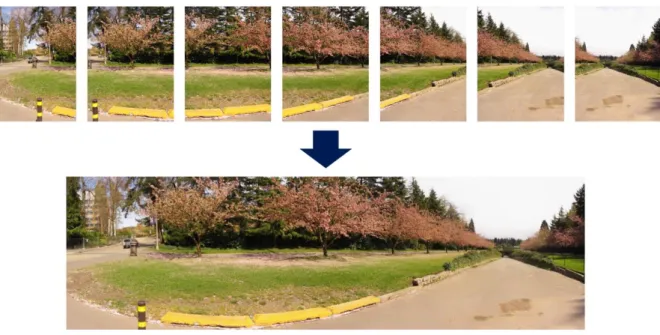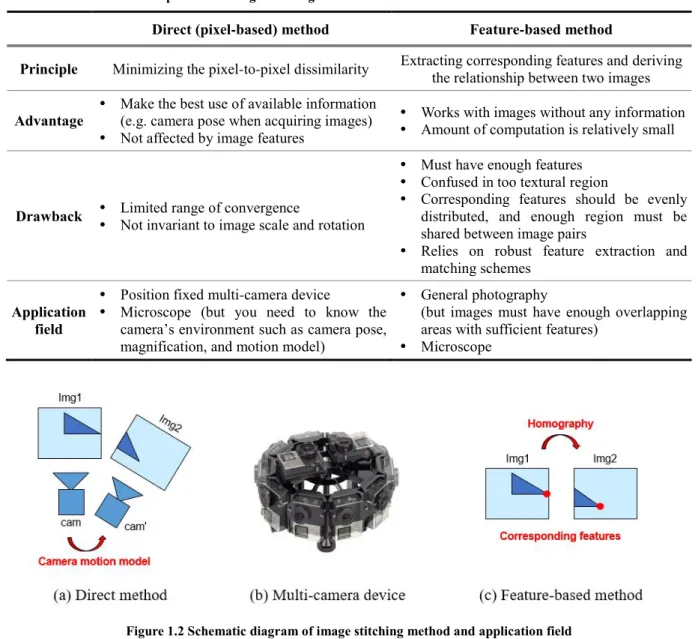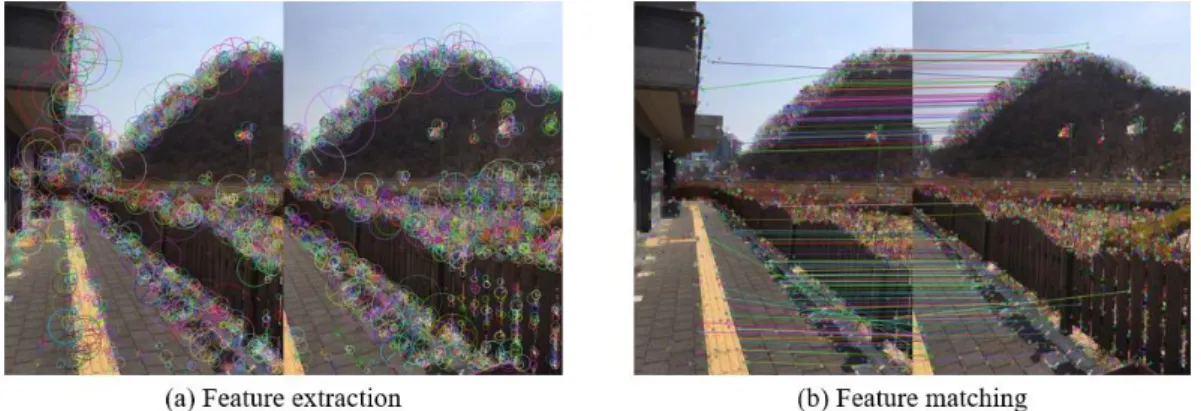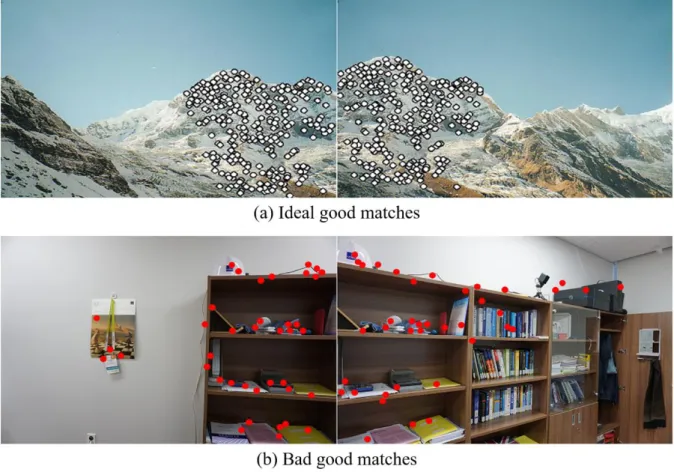Image stitching is a well-known method for making panoramic images that have a wide field of view and high resolution. The problems of existing tools are mainly caused by trying to stitch the wrong image pair. To overcome these problems, it is important to select suitable image pair for stitching in advance.
The proposed stitching parameters can be easily calculated by analyzing the relevant features and homography, which are basic elements in the feature-based image stitching algorithm. In order to determine the conditions of sewing parameters, we developed a new sewing precision calculation method to qualify sewing results into 3 classes; the good, the bad and the failed. With the classified sewing results, it was possible to check the values of the sewing parameters, how they differ in each class.
Through experiments with large data sets, the most valuable parameter for each class is identified as the filtering level which is calculated in the corresponding feature analysis. In addition, additional experiments were conducted with different datasets to demonstrate the validity of the filtering level. As a result of our study, the universal sewing parameters can judge the sewing success, so that it is possible to prevent sewing mistakes through the parameter verification test in advance.
This paper can greatly contribute to a guide to create high-performance and high-efficiency stitching software using the suggested stitching conditions.
Introduction
Purpose of research
Our research covers the creation of panoramas from multiple images captured by different cameras (or recording environments) and examines feature-based image compositing techniques. Today, feature-based image compositing algorithms have evolved to achieve good results in challenging environments. Commercially available suturing techniques to limit camera movement or fix camera placement would correct the problem.
To introduce these constraints, we focused on the criteria that could determine the correct movement and position of the camera. As an example of a yardstick (or guide) for proper movement for stitching, the camera should rotate 40 degrees to the left. Therefore, in order to determine the limits for a camera, criteria must be established based on universal parameters, as different types of cameras need to be calibrated.
If we can know in advance that a given image pair is not suitable for stitching, it can reduce stitching errors and increase stitching efficiency. Therefore, we need new criteria to indicate whether stitching is possible, and the criteria should be based on universal parameters that can be used as useful conditional statements in other software.
Overview: Feature-based image stitching
Meanwhile, in the case of panoramic software, it is important to determine whether the given image pairs are suitable for stitching. Due to the inherent characteristics of feature-based image stitching, it often fails if the available features are not sufficient. Feature-based image stitching failures also occur due to matching errors and distortion problems, even if the features are sufficient.
14] explains that the global transformation (or homography) is not suitable for real conditions of image acquisition (eg random camera movements, taken from different angles, large difference in depth, etc.). They proposed perspective-preserving distortion by combining local projective transformations and similarity transformations that avoid perspective distortions. In [15], they also use two types of deformations that combined homography and content-preserving distortion.
The application of one's own criteria has the limitation that it cannot be easily implemented or applied by other researchers.
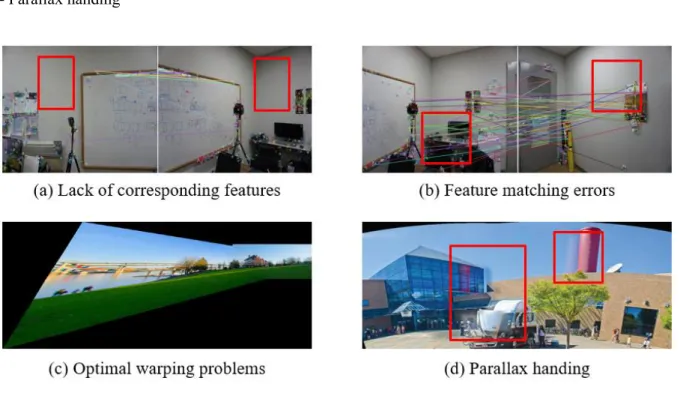
Theory of Feature-based Image Stitching
Feature-based image stitching algorithm
The planar homography is a non-simple linear relationship between points on planes, and it plays an important role in the geometry of multiple views [3]. The first 2×2 submatrix of Eq. 1) represents rotation, scale, displacement and reflection, [ℎ3, ℎ6] represents translation, [ℎ7, ℎ8] represents a perspective change. At least four corresponding points are required to estimate the homography, and the RANSAC (random sample consensus) algorithm is popularly used for good homography estimation [25].
In addition, for better results, a process called blending used to produce seamless panoramas is included in the algorithm.
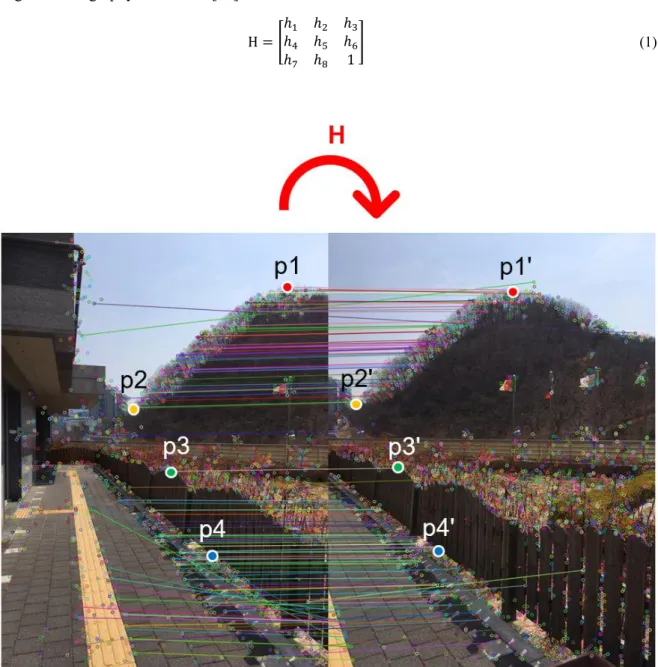
Stitching parameters
Good matches (or corresponding features) are the most basic elements in feature-based image stitching [2, 19]. The FLANN matcher maps all features in the scene to the features of the object that have the minimum distance. Then, based on min_dist, which is the value of the most relevant matches, the final good matches are determined as the matches that have the min_dist×3 relationship.
Most feature-based image stitching only determines the number of good matches to obtain a warping matrix, that is, suitable homography for stitching. In [29], if the number of good matches is more than 50% of the total image, stitching is considered possible. What we mean by the filter level is how well the good matches are filtered out of matches, and whether they are closely related to the appropriate domain.
To calculate the filter level, we need to find the matching area and the good matching area (Figure 2.7). Homography is one of the 2D transformations and can represent various geometric relationships between two images. For example, good matches for homography estimation are incorrect, or RANSAC fails to estimate proper homography.
The determinant obtained from this submatrix induces different rotation sequences or positional relationships (reflections, twists, concavities) between the points in the result of the 2D transformation (Figure 2.9). Especially in the case of the twist, since it is a change that cannot occur in the real three-dimensional space, we can judge that the anomalous homography has been achieved. Since D is an element that can cause extreme errors in the twisting process of sewing, we need to be able to determine the appropriate D value for sewing.
𝑆𝑥 is a parameter indicating the length of the X-axis unit vector with the first 2×2 submatrix in the homography matrix. 𝑆𝑦 is a parameter indicating the length of the y-axis unit vector with the first 2×2 submatrix in the homography matrix. So, the presence of perspective distortion means that the image plane of the rectangle gradually changes into a trapezoid.
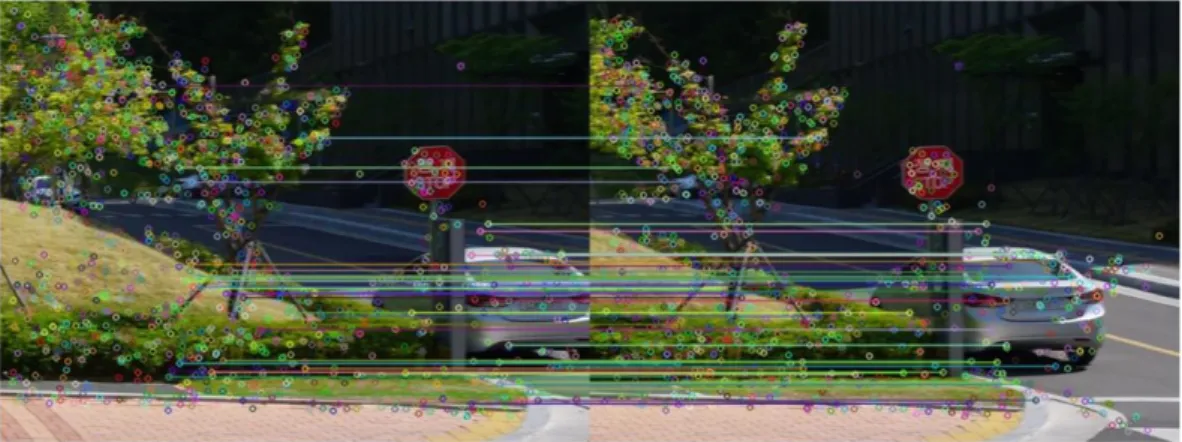
Experimental Method & Results
- Experiment 1: Efficient multiple image stitching method by grouping
- Experiment 2: Analysis of similarity between images by histogram comparison
- Experiment 3: Definition of universal stitching parameter condition
- Experiment 4: Validation of stitching parameter conditions
- Applications
Intermediate panoramas, which are the result of stitching each of the two sets, require another stitching to create the final panoramic image. Likewise, C stitches each of the three grouped images and performs final stitching with three intermediate panoramas. In the legend to the left of the graph, the first stage means the processing time to stitch the grouped images to create intermediate panoramas.
In other words, the extraction and matching of image features in feature-based image stitching has a significant effect on the speed as well as the quality of the stitching results. A color histogram focuses only on the proportion of the number of different colors, regardless of the spatial location of the colors. Therefore, we need to find the correct image pairs using the local features of the image, not the histogram.
We need to calculate the stitching accuracy to determine the conditions of the universal stitching parameters. Since the main function of the stitching is to create a comprehensive view of the image that cannot be obtained with a single camera, the ground truth cannot be captured. The purpose of our experiment is to calculate the stitching accuracy using the ground truth and to derive the values of the universal stitching parameters through the two analysis methods (similar feature analysis, homography analysis).
We present the conditions of the stitching parameters based on the accuracy with 2258 stitching results. Each of the three classes represents the sewing result as good, bad and failure and indicated by green, orange and red. We perform sewing under similar conditions to the actual sewing and calculate the values of the suggested sewing parameters.
However, we classify the quality of the results into three classes and verify how the conditions of the proposed stitching parameters are valid for the real situation. The evaluation of the stitching results was determined by subjective judgment because the existing accuracy calculation cannot be applied. Assessment of the stitching result can be divided into three classes (good, bad and failed) as shown in Figure 3.14.
To reconstruct the crime scene, it is important to understand the positional relationship and distribution of the bloodstains in three-dimensional space. The higher the magnification of the microscope, the smaller the field of view of the image.
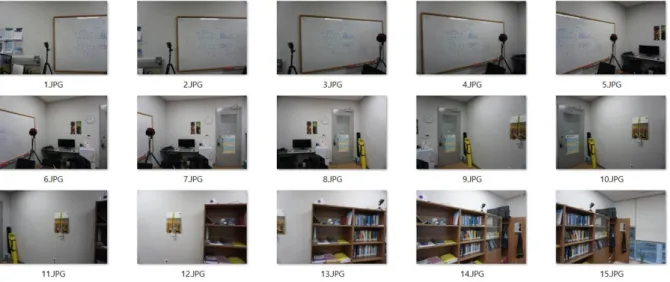
Discussion
Conclusion
Brown, "Constructing image panoramas using dual-homography warping," in IEEE Conference on Computer Vision and Pattern Recognition (CVPR), 2011, p. Chuang, "Shape-preserving halfprojective warps for image stitching," in IEEE Conference on Computer Vision and Patroonherkenning (CVPR), 2014, p. Aravkin, "Aanpasbare as-natuurlike-as- moontlike beeldstiksel," in IEEE Conference on Computer Vision and Pattern Recognition (CVPR), 2015, p.
Chuang, “Natural Image Stitching with Global Similarity Prior,” in European Conference on Computer Vision (ECCV), 2016, p. Quan, “Dual deformation based motion model evaluation,” in IEEE International Conference on Computer Vision (ICCV), 2015, p. Liu, “Parallax-tolerant image stitching,” in IEEE Conference on Computer Vision and Pattern Recognition (CVPR), 2014, p.
Lu, "Seagull: Seam-guided local alignment for parallax-tolerant image stitching," i European Conference on Computer Vision (ECCV), 2016, s. Liu, "Casual stereoscopic panorama stitching," i IEEE Conference on Computer Vision and Pattern Recognition (CVPR), 2015, s. Bradski, "ORB: et effektivt alternativ til SIFT eller SURF," i IEEE International Conference on Computer Vision (ICCV), 2011, s.
Lowe, “Fast nearest neighbor approximation with automatic algorithm configuration,” in VISAPP International Conference on Computer Vision Theory and Applications, 2009, p. Daniilidis, “Fast Multi-Image Matching via Density-Based Clustering,” in IEEE International Conference on Computer Vision (ICCV), 2017, p. Herley, “Automatic occlusion removal from a minimum number of images,” in IEEE International Conference on Image Processing (ICIP), 2005, p.
34;MIST: Accurate and Scalable Microscopy Image Stitching Tool with Stage Modeling and Error Minimization," Scientific reports, vol. The words of the professors will be a great force for my life in the future. Thank you very much for guiding me who has no knowledge of image processing and computer vision so far.
